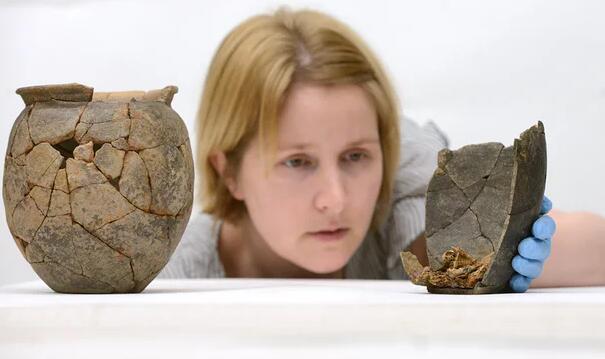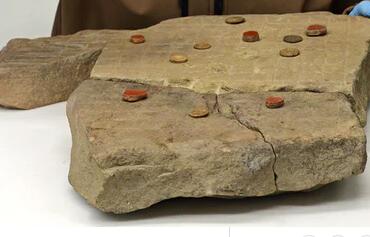Information
Roman cremation urns go on display for first time
Summary: The remains of a child who lived in the shadow of Hadrian’s Wall, and a woman who may have been the mother, will go on display for the first time in an exhibition at Birdoswald Roman Fort.The cremated remains were found with enigmatic grave goods includin
The remains of a child who lived in the shadow of Hadrian’s Wall, and a woman who may have been the mother, will go on display for the first time in an exhibition at Birdoswald Roman Fort.
The cremated remains were found with enigmatic grave goods including a piece of iron-ring-mail Roman armour.
“We don’t know the relationship between the two but we can be sure that there was one,” said Frances McIntosh, curator of Roman collections. “The cremated remains of a young child were buried first, but when the pit was dug for the urn containing the remains of the woman it was very deliberately overlaid and partly cut into the earlier burial pit.

Frances McIntosh, curator of Roman collections at English Heritage, with the cremation urns, to go on display at Birdoswald Fort, Hadrian’s Wall. Photograph: Craig Connor/NNP/English Heritage
“Visitors still often come to Hadrian’s Wall expecting that it was entirely the realm of burly, hobnailed, sandal-wearing, Latin-speaking Roman soldiers - but the picture was far less simple than that. We know that there were many women here, and children too, and the new display is an opportunity to bring them out of the shadows.”
The two urns were discovered in 2009 in a burial ground just outside the walls of the fort, which stands on land cleared to build Hadrian’s Wall. McIntosh wonders if the piece of mail, an unusual object to find buried with a woman, suggests that she and the child, aged about five – the age was calculated from a tooth which survived the cremation process – were the family of a legionary stationed on the wall. Ordinary Roman soldiers were not officially allowed to marry until AD197 – 75 years after construction started on Hadrian’s Wall – but many finds, including tombstones of wives and children, suggest that a blind eye was often turned.

This Roman board game is also on display at Corbridge. Photograph: Craig Connor/NNP/English Heritag/PA
The museum at the site of Corbridge – a settlement which predated the wall, but became a prosperous town with a large civilian population, the most northern town in the Roman empire – has also been redisplayed to widen the picture of life on and near the wall.
The site is known for the hoard of military objects including armour, bundles of spearheads still tied together, textiles and leatherwork, found in an iron-bound chest in the 1960s. Now children’s games and toys, and a beautiful, blue, enamel copper perfume vase, which must have belonged to a woman of high status and was found in a cremation burial from the early second century, are among the objects going on display for the first time. Both exhibitions open on Friday.
The cremated remains were found with enigmatic grave goods including a piece of iron-ring-mail Roman armour.
“We don’t know the relationship between the two but we can be sure that there was one,” said Frances McIntosh, curator of Roman collections. “The cremated remains of a young child were buried first, but when the pit was dug for the urn containing the remains of the woman it was very deliberately overlaid and partly cut into the earlier burial pit.

Frances McIntosh, curator of Roman collections at English Heritage, with the cremation urns, to go on display at Birdoswald Fort, Hadrian’s Wall. Photograph: Craig Connor/NNP/English Heritage
“Visitors still often come to Hadrian’s Wall expecting that it was entirely the realm of burly, hobnailed, sandal-wearing, Latin-speaking Roman soldiers - but the picture was far less simple than that. We know that there were many women here, and children too, and the new display is an opportunity to bring them out of the shadows.”
The two urns were discovered in 2009 in a burial ground just outside the walls of the fort, which stands on land cleared to build Hadrian’s Wall. McIntosh wonders if the piece of mail, an unusual object to find buried with a woman, suggests that she and the child, aged about five – the age was calculated from a tooth which survived the cremation process – were the family of a legionary stationed on the wall. Ordinary Roman soldiers were not officially allowed to marry until AD197 – 75 years after construction started on Hadrian’s Wall – but many finds, including tombstones of wives and children, suggest that a blind eye was often turned.

This Roman board game is also on display at Corbridge. Photograph: Craig Connor/NNP/English Heritag/PA
The site is known for the hoard of military objects including armour, bundles of spearheads still tied together, textiles and leatherwork, found in an iron-bound chest in the 1960s. Now children’s games and toys, and a beautiful, blue, enamel copper perfume vase, which must have belonged to a woman of high status and was found in a cremation burial from the early second century, are among the objects going on display for the first time. Both exhibitions open on Friday.
Category: English
News
Information
Key words:
